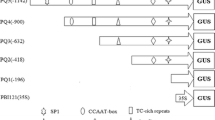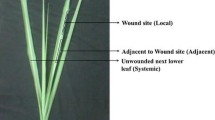Abstract
To attain high transgene expression in petal tissue of ray florets of chrysanthemum an endogenous ubiquitin extension protein (UEP1) promoter was cloned and tested with the β-glucuronidase (GUS) reporter gene. Expression levels were compared with four heterologous promoters: chalcone synthase (chs-A) and zinc finger transcription factor (EPF2-5) from petunia, eceriferum (CER6) from Arabidopsis and multicystatin (PMC) from potato. The comparison of the expression levels of the different constructs in ray florets, disc florets, and leaves is presented. The highest mean expression in petal tissue of ray and disc florets was conferred by the UEP1 promoter, followed by CER6 and EPF2-5. The UEP1 promoter in ray florets confers over 50-fold enhancement in expression as compared to CaMV 35S-based promoters.
Similar content being viewed by others
References
Ackers CP and Hoff JE (1980) Simultaneous formation of chymo-papain inhibitor activity and cubical crystals in tomato leaves. Can J Bot 58: 1000–1003.
Anderson NO (1987) Reclassification of the genus Chrysanthemum L. Hort Sci 22: 313.
Annadana S, Mlynarova L, Udayakumar M, de Jong J and Nap JPH (2002) The potato Lhca3.St.1 promoter confers high and stable transgene expression in chrysanthemum, in contrast to CaMV-based promoters. Mol Breed 8: 335–344.
Boase MR, Bradley JM and Borst NK (1998) Genetic transformation by Agrobacterium tumefaciens of florists chrysanthemum (Dendranthema X Grandiflorium) cultivar Peach Margaret. Vitro Cell Dev Biol Plant 34: 46–51.
Cuijpers TAMM (1994) SPOD-X GH, recently registered in the Netherlands as a viral insecticide for control of beet army worm Spodoptera exigua in cutflowers and potted plants in greenhouses. Mededelingen Faculteit Landbouwkundige en Toegepaste Biologische Wetenschappen Universiteit Gent 59: 393–403.
De Jager CM, Butot RPT, Klinkhamer PGL and Van Der Meijden E (1995) Chemical characteristics of chrysanthemum cause resistance to Frankliniella occidentalis (Thysanoptera: Thripidae). J Econ Entomol 88: 1746–1753.
De Jong J, Rademaker W and Ohishi K (1995) Agrobacterium-mediated transformation of chrysanthemum. Plant Tissue Cult Biotechnol 1: 38–42.
Dolgov SV, Mityshkina TU, Rukavtsova EB, Buryanov YI, Vain-stein A and Weiss D (1995) Production of transgenic plants of Chrysanthemum morifolium Ramat with the Bacillus thuringiensis delta endotoxin. Acta Hort 420: 46–47.
Farmer EE and Ryan CA (1992) Octadecanoid precursors of jas-monic acid activate the synthesis of wound-inducible proteinase inhibitors. Plant Cell 4: 129–134.
Hannoufa A, Negruk V, Eisner G and Lemieux B (1996) The CER3 gene of Arabidopsis thaliana is expressed in leaves, stems, roots, flowers and apical meristems. Plant J 10: 459–467.
Helariutta Y, Elomaa P, Kotilainen M, Seppanen P and Teeri TH (1993) Cloning of cDNA coding for dihydroflavonol-4-reductase (DFR) and characterisation of dfr expression in the corollas of Gerbera hybrida var. Regina (Compositae). Plant Mol Biol 22: 183–193.
Hood EE, Gelvin SB, Melchers LS and Hoekema A (1993) New Agrobacterium helper plasmids for gene transfer to plants. Transgenic Res 2: 208–218.
Jefferson RA, Kavanagh TA and Bevan MW (1987) GUS fusion: β-glucuronidase as a sensitive and versatile gene fusion marker in higher plants. EMBO J 6: 3901–3907.
Ledger SE, Deroles SC and Given NK (1991) Regeneration and Agrobacterium mediated transformation of chrysanthemum. Plant Cell Rep 10: 195–199.
Mlynarova L, Loonen A, Heldens J, Jansen RC, Keizer P, Stiekema WJ and Nap JP (1994) Reduced position effect in mature transgenic plants conferred by the chicken lysozyme matrix-associated region. Plant Cell l6: 417–426.
Nap JP, Keizer P and Jansen R (1993) First generation transgenic plants and statistics. Plant Mol Biol Rep 11: 156–164.
Renou JPP, Brochard P and Jalouzout R (1993) Recovery of trans-genic chrysanthemum Dendranthema grandiflora after hygromycin resistance selection. Plant Sci 89: 185–187.
Ruan Y, Gilmore J and Conner T (1998) Towards Arabidopsis genome analysis: monitoring expression profiles of 1400 genes using cDNA microarrays. Plant J 15: 821–833.
Sherman JM, Moyer JW and Daub ME (1998) Tomato Spotted Wilt Virus resistance in chrysanthemum expressing the viral nucleocapsid gene. Plant Dis 82: 407–414.
Takatsuji H, Nakamura N and Katsumoto Y (1994) A new family of Zinc finger proteins in petunia: structure, DNA sequence recognition and floral organ-specific expression. Plant Cell 6: 947–958.
Van der Meer I, Spelt CE, Mol NM and Stuitje AR (1990) Promoter analysis of the chalcone synthase (chs-A) geneofPetunia hybrida: a 67 bp promoter region directs flower-specific expression. Plant Mol Biol 15: 95–109.
Van Engelen FA, Molthoff JW, Conner AJ, Nap JP, Pereira A and Stiekema WJ (1995) PBINPLUS: an improved plant transformation vector based on pBIN19. Transgen Res 4: 288–290.
Van Wordragen MF, Honée G and Dons HJM (1993) Insect-resistant chrysanthemum calluses by introduction of a Bacillus thuringiensis crystal protein gene. Transgen Res 2: 170–180.
Waldron C, Lynette M, Wegrich P, Merlo AO and Walsh TA (1993) Characterisation of a genomic sequence coding for potato multicystatin, an eight domain cysteine proteinase inhibitor. Plant Mol Biol 23: 801–812.
Walsh TA and Strickland JA (1993) Proteolysis of the 85-kilodalton crystalline cysteine proteinase inhibitor from potato releases functional cystatin domains. Plant Physiol 103: 1227–1234.
Williams CA, Harborne JB, Geiger H and Hoult JRS (1999) The flavonoids of Tanacetum parthenium and T. vulgare and their anti-inflammatory properties. Phytochemistry 51: 417–423.
Wilmink A, Vanden Ven B and Dons H (1992) Expression of the GUS gene in the monocot tulip after introduction by particle bombardment Agrobacterium. Plant Cell Rep 11: 76–80.
Author information
Authors and Affiliations
Corresponding author
Rights and permissions
About this article
Cite this article
Annadana, S., Beekwilder, M., Kuipers, G. et al. Cloning of the Chrysanthemum UEP1 Promoter and Comparative Expression in Florets and Leaves of Dendranthema Grandiflora . Transgenic Res 11, 437–445 (2002). https://doi.org/10.1023/A:1016313924844
Issue Date:
DOI: https://doi.org/10.1023/A:1016313924844




